The history of Pac-Man
- Transfer
On November 30, RUVDS, together with the Museum of Soviet Gaming Machines, will hold the first Game Overnight old-school video game tournament in Russia. The preliminary tournament continues on the game site , and there is less and less time before the final. In the meantime, we decided to recall the history of the creation of the cult game Pac-Man.
For Namco, in the early 1980s, Pac-Man was a huge event. She, without exaggeration, turned into a real symbol of the 20th century. It is hardly possible to find someone who, if he did not play Pac-Man, at least did not hear about this game, since it became one of the first phenomena of the game world, which penetrated into the sphere of popular culture. In fact, the game was so popular that the additional revenues of Namco associated with Pac-Man exceeded those that the company received from the sale of slot machines.

The interest in the game was so great that the companies involved in slot machines ordered several devices at once, rather than one at a time, which was usual for new games. Such a strategy seemed justified in the light of the possible loss of income due to the fact that people had to stand in line to play Pac-Man. Therefore, in the halls they put on several automatic machines, trying to collect more coins in their boxes for money, which was good for gaming owners and for Namco.
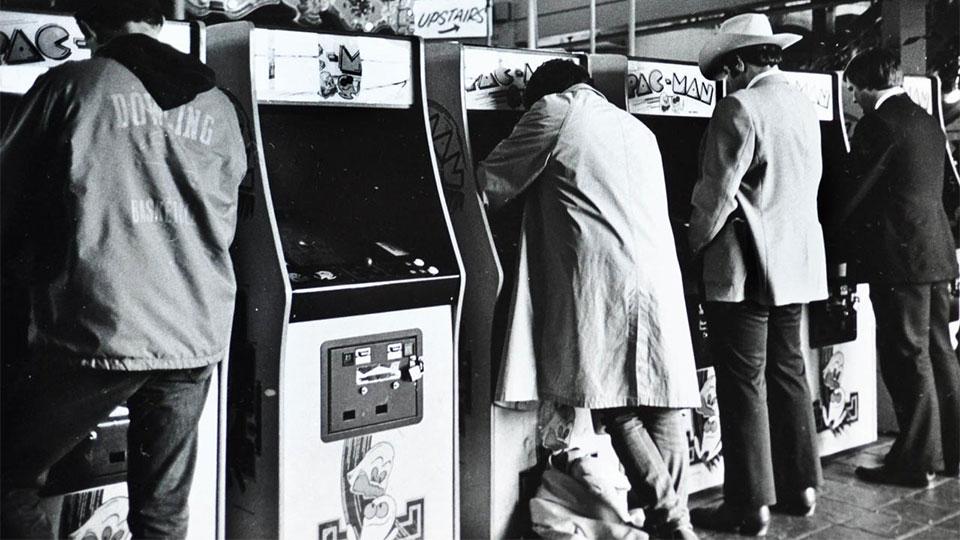
The creator of Pac-Man, Toru Ivatani, came to Namco, which was then called Nakamura Manufacturing, in 1977, when he was 22 years old. At first, he was engaged in repairing boards of licensed black and white Atari video games, which were distributed in Japan. But Toru didn’t particularly like repairing the glands. He was a big fan of pinball and informed management that he was working on a video version of this game. It so happened that the first Namco arcade video game, Gee Bee, which, moreover, was successful, developed the Torah. Inspired with success, Namco, in 1979, releases Galaxian - the very first game with color graphics. At the time, this was a revolutionary achievement. Galaxian game was a huge hit. It was based on the idea of the Space Invaders game, to which kamikaze enemies were added, who swoop down on the player’s ship.
Ivatani understood that the market was dominated by games created by analogy with the early successful shooters, and drew inspiration from the works of overseas Atari, who enjoyed universal adoration (and received good profits) through their games - bright, colorful, implementing many different ideas and concepts. He was particularly encouraged by the fact that the games that Atari created were, by nature, “positive.” He wanted to create something that would be built on the same model.

Instead of focusing on "shooters", Ivatani explored topics that would be interesting not only for male players, but would be attractive for couples and women. These categories of players perceived games differently than men:
Then, together with a team of eight programmers and designers, Ivatani set to work. Ideas followed one after another, some ideas improved, others refused, not corresponding to the concept of the game, refused. Development lasted 18 months.
Ivatani saw the protagonist of the game in a pizza ordered by him once, one of which he already managed to take from the plate. Helping himself with pizza, he looked at what was left of her and saw that the character of the game was watching him. Pac-Man (Pacman) was made friendly - so people could associate themselves with it. Adding ghosts to the game gave her the mood of Tom and Jerry cartoons, and this, Ivatani believed, was to appeal to a wide audience of players. Despite the fact that he was advised to add the main character's eyes, hair and other details, he persistently refused from all this, deciding that the character should be a simple figure painted over with a pure yellow color. As a result, Pakman and ghosts turned out simple and attractive.
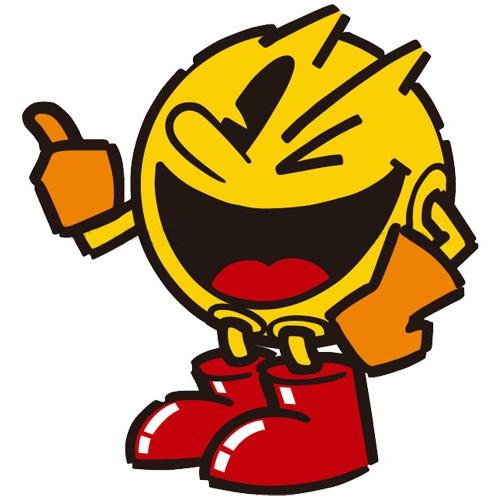
The initial idea that the bonuses in the game should look like fruits was inspired by the fact that such images were used in slot machines that can be found in the casino. It was very American and very cool.
Transition tunnels appeared in the game at a late stage of development, and the “energizers” were added there under the impression of the hero of cartoons Popay, who, after eating a jar of spinach, gains super power and gives a fitting rebuff to his opponent Bluto.
From the game, the valves that were initially available were removed, which could open and close, blocking the corridors of the maze in certain places. When testing the game, it turned out that the player is one frustration from them, so they were removed from the final game code.
Ivatani wanted the game to attract players:
In addition, Ivatani took into account the feelings of the player. Running through the maze of ghosts causes a feeling of fear and panic. This tension was the very thing that fascinates the player, but the creator of Pac-Man wanted to balance the game. So there were "energizers" and artificial intelligence of ghosts.
There were moments in the behavior of ghosts (the so-called “scatter mode”) when they cease to chase the player and move each to their own corner of the labyrinth. This allows you to make the game less stressful, to give the player a chance to take a break and think about their next steps.
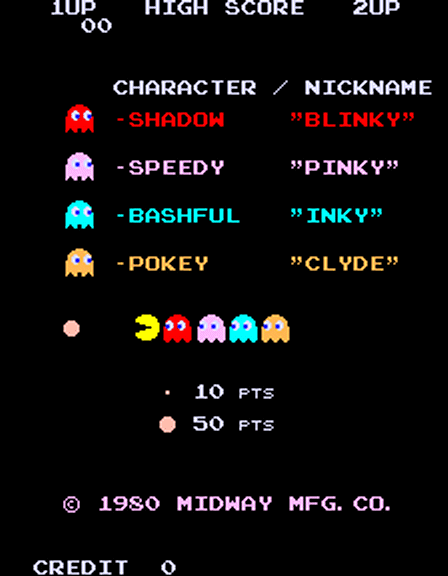
The role of enemies in Pac-Man is fulfilled by four multi-colored ghosts - Blinky, Pinky, Clyde and Inca. It took a lot of programming effort to develop them. Imagine that four enemies are continuously pursuing Pakman, driven by the same set of rules. They, sooner or later, line up behind each other, following the main character through the maze and doing nothing interesting. In order to prevent this, algorithms have been developed, thanks to which ghosts, on the one hand, do their work in pursuit of the hero, and on the other, behave differently. If you very briefly describe the features of each of the ghosts, you get the following:
It is worth noting here that the ghosts, in fact, do not have real “artificial intelligence”, although it may seem that this is not the case. They simply follow the algorithms, which creates a sense of their "rationality." As a result, it turns out that in the labyrinth there is Pakman and four unique enemies pursuing him. This makes the game interesting, addictive and fun.
We believe it will be curious to take a look at the first rough sketches that Iwatani made while working on the maze and on the characters of the game.

In this early outline of the labyrinth, you can see the absence of tunnels along the edges of the screen, and the fact that the corner zones of the labyrinth, both above and below, are not arranged as in the final version of the game.
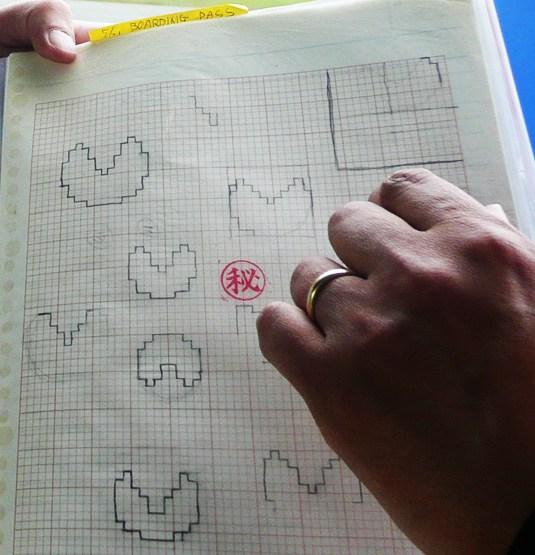
And here are the early models of Pacman himself.
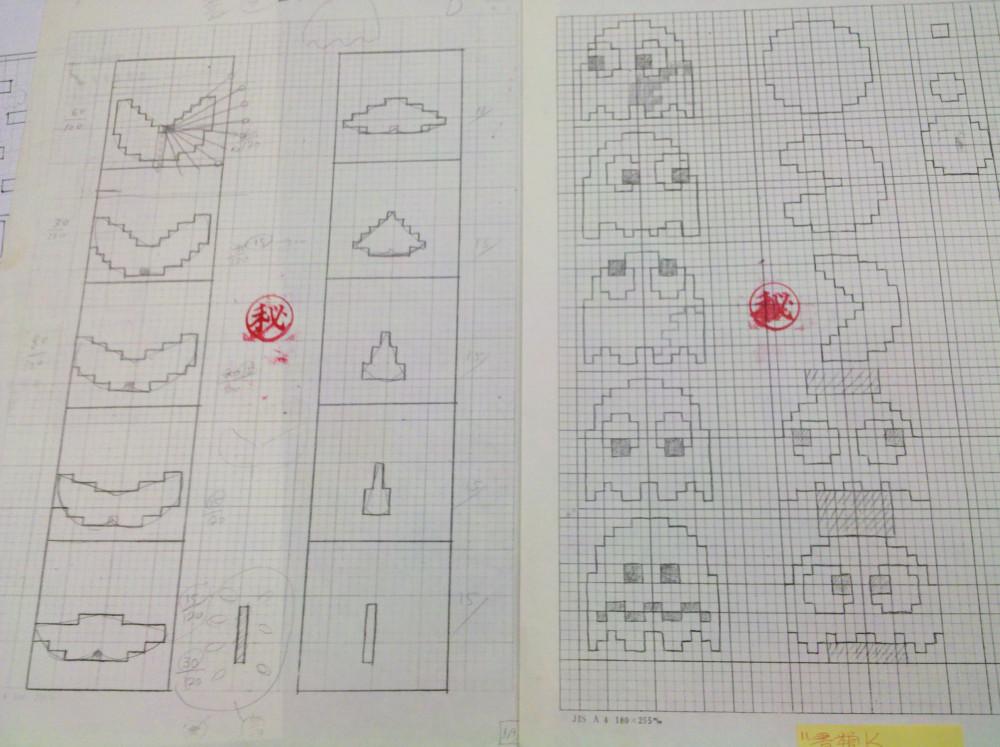
Here, on the left, shows the storyboard of Pacman’s “death” animation, and on the right, the outline of ghosts.
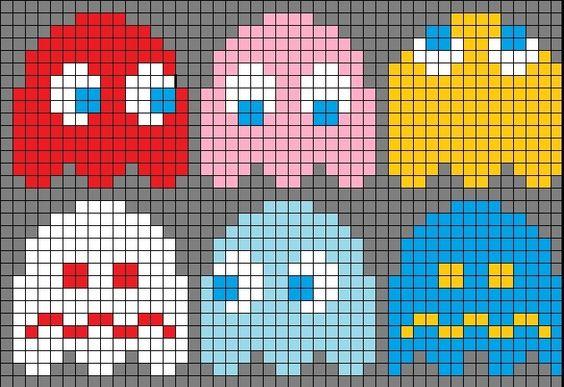
Here is the final pixel rendering of ghosts.
Ivatani insisted that what was called “coffee breaks” - animated screensavers - come into play. Against this was one of the programmers, Shigeo Funaki, but Ivatani believed that they give the player an incentive to continue the game, create interest in what will happen next, and, as a result, the screen savers in the game remain.
Turning to psychology again, Iwatani wanted the player to understand the reasons for completing the game, to see what he did wrong. He wanted players to create strategies that would allow them to avoid the same end of the game in the future. And, of course, all this meant that the player would want to play again and again in order to learn how to play better.
When the developers managed to assemble the main components of the game and better understand its purpose, the protagonist got the nickname “Pakku Man” from the Japanese slang term “paku-paku”, which describes the sounds made by a person’s mouth during a meal. Subsequently, this led to the fact that the game, with its release in Japan, was called Puck Man. But Namco representatives in America quickly decided to change the name of the game to “Pac Man”, fearing that the letter “P” at the beginning of the first word of the name can be easily replaced with “F”. “Arcade vandal” needs only a marker and a little luck.

It is interesting to note that, after the game was released in the USA in 1980, neither distributors nor representatives of game development companies noticed it at first. There was a feeling that another machine, Rally X, released by Namco at the same time, is waiting for a big success. But by the end of 1982, more than 400,000 Pac-Man machines had been sold, and, across America, this game was played about 7 billion times. The game turned into a huge phenomenon, it was a surprise for everyone, and, by the end of the decade, gave more revenue than the most successful film of that time - “Star Wars”.

Ivatani tenderly treated the game, often called her his “child”, knew her up and down, but it turned out that she was able to surprise even him, gradually revealing her secrets to the players. So, the first person who “beat” Pac-Man, having passed all his levels, became the American Billy Mitchell. He, recalling the meeting with Ivatani after this achievement, said that he had asked him about some of the features of the game he had discovered. He was interested to know whether it was intentional. After Ivatani conferred with his colleagues, he answered the following:
As a result, although Ivatani spent 18 months creating the game, giving it life, the game itself "disposed" of its secrets, passing it off to Mitchell and his friends. There are quite a few oddities and unintended errors in the game, like the ability to find a place in the maze where ghosts do not see Pacman, or the ability to pass through ghosts, not to mention the notorious 256-level crash screen where the game ends because of restrictions 8-bit code. Here is this screen.

After the release of the game Pac-Man almost forty years have passed, but it is still literally everywhere. One should not underestimate its impact on the adoption of gaming by society, on the understanding that achievements in games are as real as in other areas of life. The game, after the appearance, continued and continues to be reissued, and its symbol, Pakman, left its boundaries long ago, having set off to travel the world.

By the way, if you want to learn more about the internal mechanisms of Pac-Man - take a look here .

For Namco, in the early 1980s, Pac-Man was a huge event. She, without exaggeration, turned into a real symbol of the 20th century. It is hardly possible to find someone who, if he did not play Pac-Man, at least did not hear about this game, since it became one of the first phenomena of the game world, which penetrated into the sphere of popular culture. In fact, the game was so popular that the additional revenues of Namco associated with Pac-Man exceeded those that the company received from the sale of slot machines.

The interest in the game was so great that the companies involved in slot machines ordered several devices at once, rather than one at a time, which was usual for new games. Such a strategy seemed justified in the light of the possible loss of income due to the fact that people had to stand in line to play Pac-Man. Therefore, in the halls they put on several automatic machines, trying to collect more coins in their boxes for money, which was good for gaming owners and for Namco.

The creator of Pac-Man, Toru Ivatani, came to Namco, which was then called Nakamura Manufacturing, in 1977, when he was 22 years old. At first, he was engaged in repairing boards of licensed black and white Atari video games, which were distributed in Japan. But Toru didn’t particularly like repairing the glands. He was a big fan of pinball and informed management that he was working on a video version of this game. It so happened that the first Namco arcade video game, Gee Bee, which, moreover, was successful, developed the Torah. Inspired with success, Namco, in 1979, releases Galaxian - the very first game with color graphics. At the time, this was a revolutionary achievement. Galaxian game was a huge hit. It was based on the idea of the Space Invaders game, to which kamikaze enemies were added, who swoop down on the player’s ship.
Ivatani understood that the market was dominated by games created by analogy with the early successful shooters, and drew inspiration from the works of overseas Atari, who enjoyed universal adoration (and received good profits) through their games - bright, colorful, implementing many different ideas and concepts. He was particularly encouraged by the fact that the games that Atari created were, by nature, “positive.” He wanted to create something that would be built on the same model.

Instead of focusing on "shooters", Ivatani explored topics that would be interesting not only for male players, but would be attractive for couples and women. These categories of players perceived games differently than men:
In the late seventies, the game rooms, which we, in Japan, called “game centers,” were places where only boys and young men spent their time. The only job he offered was the killing of aliens. I wanted to come up with a charming game that you can love, one that would be easy to play. It was supposed to be a fun, fun game that would suit both couples and women. When it came time to work on the idea of the game, I thought that it needed to be built around a certain verb. I went through a lot of words, such as “grab” and “surround.” At that time, it was possible to observe the spread of board games, including a significant number of gaming machines installed in cafes and other similar places. I thought that the game, somehow related to cooking, based on the verb "is",
Then, together with a team of eight programmers and designers, Ivatani set to work. Ideas followed one after another, some ideas improved, others refused, not corresponding to the concept of the game, refused. Development lasted 18 months.
Ivatani saw the protagonist of the game in a pizza ordered by him once, one of which he already managed to take from the plate. Helping himself with pizza, he looked at what was left of her and saw that the character of the game was watching him. Pac-Man (Pacman) was made friendly - so people could associate themselves with it. Adding ghosts to the game gave her the mood of Tom and Jerry cartoons, and this, Ivatani believed, was to appeal to a wide audience of players. Despite the fact that he was advised to add the main character's eyes, hair and other details, he persistently refused from all this, deciding that the character should be a simple figure painted over with a pure yellow color. As a result, Pakman and ghosts turned out simple and attractive.

The initial idea that the bonuses in the game should look like fruits was inspired by the fact that such images were used in slot machines that can be found in the casino. It was very American and very cool.
Since Pac-Man is a game that needs something to eat, we started adding cherries, strawberries, oranges and other fruits. And after we started to run out of ideas, we paid attention to the characters of the game Galaxian and something like keys.
Transition tunnels appeared in the game at a late stage of development, and the “energizers” were added there under the impression of the hero of cartoons Popay, who, after eating a jar of spinach, gains super power and gives a fitting rebuff to his opponent Bluto.
From the game, the valves that were initially available were removed, which could open and close, blocking the corridors of the maze in certain places. When testing the game, it turned out that the player is one frustration from them, so they were removed from the final game code.
Ivatani wanted the game to attract players:
The game should be clear at a glance. It is necessary that its goal could be explained, at most, in two sentences. In modern games, I do not see it - they are too complicated. Of course, these complex games attract hardcore players, but if you want the game to gain wide popularity, you need to do something simple and pleasant. This can be done only by studying human behavior. My main goal in creating the game was to make the player enjoy it. Positive is the most important thing.
In addition, Ivatani took into account the feelings of the player. Running through the maze of ghosts causes a feeling of fear and panic. This tension was the very thing that fascinates the player, but the creator of Pac-Man wanted to balance the game. So there were "energizers" and artificial intelligence of ghosts.
There were moments in the behavior of ghosts (the so-called “scatter mode”) when they cease to chase the player and move each to their own corner of the labyrinth. This allows you to make the game less stressful, to give the player a chance to take a break and think about their next steps.

The role of enemies in Pac-Man is fulfilled by four multi-colored ghosts - Blinky, Pinky, Clyde and Inca. It took a lot of programming effort to develop them. Imagine that four enemies are continuously pursuing Pakman, driven by the same set of rules. They, sooner or later, line up behind each other, following the main character through the maze and doing nothing interesting. In order to prevent this, algorithms have been developed, thanks to which ghosts, on the one hand, do their work in pursuit of the hero, and on the other, behave differently. If you very briefly describe the features of each of the ghosts, you get the following:
- Blinky: the red ghost, haunting Pakman without much fuss.
- Pinky: A pink ghost that targets a position 32 pixels away from the front of the main character.
- Inca: a blue ghost seeking to get to a point found by a special algorithm that takes into account the position of the player and another ghost - Blinky.
- Clyde: an orange ghost, which, depending on the distance from the main character, then chases after Pacman, then goes to the lower left corner of the maze.
It is worth noting here that the ghosts, in fact, do not have real “artificial intelligence”, although it may seem that this is not the case. They simply follow the algorithms, which creates a sense of their "rationality." As a result, it turns out that in the labyrinth there is Pakman and four unique enemies pursuing him. This makes the game interesting, addictive and fun.
We believe it will be curious to take a look at the first rough sketches that Iwatani made while working on the maze and on the characters of the game.

In this early outline of the labyrinth, you can see the absence of tunnels along the edges of the screen, and the fact that the corner zones of the labyrinth, both above and below, are not arranged as in the final version of the game.

And here are the early models of Pacman himself.

Here, on the left, shows the storyboard of Pacman’s “death” animation, and on the right, the outline of ghosts.

Here is the final pixel rendering of ghosts.
Ivatani insisted that what was called “coffee breaks” - animated screensavers - come into play. Against this was one of the programmers, Shigeo Funaki, but Ivatani believed that they give the player an incentive to continue the game, create interest in what will happen next, and, as a result, the screen savers in the game remain.
Turning to psychology again, Iwatani wanted the player to understand the reasons for completing the game, to see what he did wrong. He wanted players to create strategies that would allow them to avoid the same end of the game in the future. And, of course, all this meant that the player would want to play again and again in order to learn how to play better.
When the developers managed to assemble the main components of the game and better understand its purpose, the protagonist got the nickname “Pakku Man” from the Japanese slang term “paku-paku”, which describes the sounds made by a person’s mouth during a meal. Subsequently, this led to the fact that the game, with its release in Japan, was called Puck Man. But Namco representatives in America quickly decided to change the name of the game to “Pac Man”, fearing that the letter “P” at the beginning of the first word of the name can be easily replaced with “F”. “Arcade vandal” needs only a marker and a little luck.

It is interesting to note that, after the game was released in the USA in 1980, neither distributors nor representatives of game development companies noticed it at first. There was a feeling that another machine, Rally X, released by Namco at the same time, is waiting for a big success. But by the end of 1982, more than 400,000 Pac-Man machines had been sold, and, across America, this game was played about 7 billion times. The game turned into a huge phenomenon, it was a surprise for everyone, and, by the end of the decade, gave more revenue than the most successful film of that time - “Star Wars”.

Ivatani tenderly treated the game, often called her his “child”, knew her up and down, but it turned out that she was able to surprise even him, gradually revealing her secrets to the players. So, the first person who “beat” Pac-Man, having passed all his levels, became the American Billy Mitchell. He, recalling the meeting with Ivatani after this achievement, said that he had asked him about some of the features of the game he had discovered. He was interested to know whether it was intentional. After Ivatani conferred with his colleagues, he answered the following:
Mr Mitchell. We do not know. It was not supposed that the game can be played for so long.
As a result, although Ivatani spent 18 months creating the game, giving it life, the game itself "disposed" of its secrets, passing it off to Mitchell and his friends. There are quite a few oddities and unintended errors in the game, like the ability to find a place in the maze where ghosts do not see Pacman, or the ability to pass through ghosts, not to mention the notorious 256-level crash screen where the game ends because of restrictions 8-bit code. Here is this screen.

After the release of the game Pac-Man almost forty years have passed, but it is still literally everywhere. One should not underestimate its impact on the adoption of gaming by society, on the understanding that achievements in games are as real as in other areas of life. The game, after the appearance, continued and continues to be reissued, and its symbol, Pakman, left its boundaries long ago, having set off to travel the world.

By the way, if you want to learn more about the internal mechanisms of Pac-Man - take a look here .

